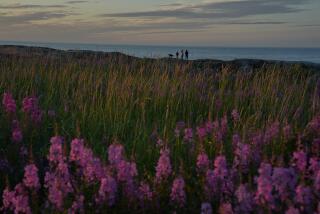Arctic Expeditions Trouble Canadians
- Share via
RESOLUTE BAY, Northwest Territories — Travelers to the Canadian Arctic abound, summer and winter. Some are experienced and well-equipped, others what a Mountie calls granola trekkers: “all fruits, flakes and nuts.”
Take, for example, the Briton who came in search of “ancient igloos” to trace early Eskimo migrations. He had acclimatized himself by sitting in a freezer.
Some visitors treat Canada’s vast, wondrous northland as if it were a no-man’s-land with no inhabitants or laws. They include people who destroy wildlife such as polar bear and musk ox, and sometimes disrupt Eskimo archeological sites.
That sort of conduct worries the government.
“We are not concerned about bona fide, legitimate, well-organized expeditions taking a crack at the Pole,” said Ken MacRury, director of the Baffin Region in the eastern Arctic.
“Nor are we concerned about the tourist who drives up from Edmonton to fish in the Great Slave Lake,” he said. “It’s those in the middle, the junketeers that come into the north and create all kinds of problems for themselves and for us.”
MacRury and the Royal Mountie, Staff Sgt. Jack Kruger, both based at Iqaluit on Baffin Island, are on a newly formed Arctic Expeditions Committee of federal and territorial government officials. Its assignment is to draw up rules for arctic adventuring.
Among the committee’s main concerns are the legal and financial implications for governments when emergency operations are necessary to find and rescue poorly prepared expeditions.
Not everybody thinks the committee, or regulation, is a good idea.
“I don’t see any point in having a policeman where there are no thieves,” said Bezal Jesudason, probably the best-known outfitter in the high Arctic. “On one hand they talk about promoting tourism, and on the other, creating a bureaucracy to inhibit it.”
Jesudason, an Indian from steamy Madras who became one of the world’s foremost experts on arctic travel, favors letting people do what they want, as long as they can pay for it.
“They make the world interesting,’ he said. “As long as you don’t hurt me and don’t bother me, what’s the difference?”
He bristles at the suggestion that some arctic adventurers are lunatics.
“Is he a lunatic,” the outfitter asked, “or is he somebody doing something out of the ordinary?
“Some things sound a little crazy. Some Swiss guys want to go to the magnetic North Pole on mountain bikes. I told them they wouldn’t be able to pedal, but to come here and try it. We always make sure they are physically safe and recommend the best Inuit guides for them.
“If somebody wants to go on a pogo stick, that’s fine.”
Jesudason also runs a small inn in Resolute Bay, a community of 160 people that is the jump-off point for most polar expeditions. He claims that no expedition in recent memory has had to be rescued by the Canadian government.
Kruger said most poorly planned or outfitted expeditions “never get more than a mile or two out of town,” and that many people have been talked out of attempting some of the nuttier ideas.
According to Jesudason, the government spends more money rescuing locals. He said they seem to have become more careless in recent years and lack the knowledge of their forefathers.
Something is bound to happen sooner or later “when someone in England believes he can find ancient igloos or sit in a freezer to get acclimatized,” said David Grindlay, who advises the territorial Department of Economic Development and Tourism in Yellowknife
MacRury said “it’s more of a potential problem” at this point, but “one of these expeditions is going to get into serious trouble, and we’ll be left to pick up the pieces.”
One proposed trip this year is by a party of Britons who want to tool around the Arctic Circle, 66.5 degrees north latitude, in four-wheel-drive vehicles with trailers.
The Northwest Territories Science Institute described the idea as a “rash adventure” and “nonsensical.”






